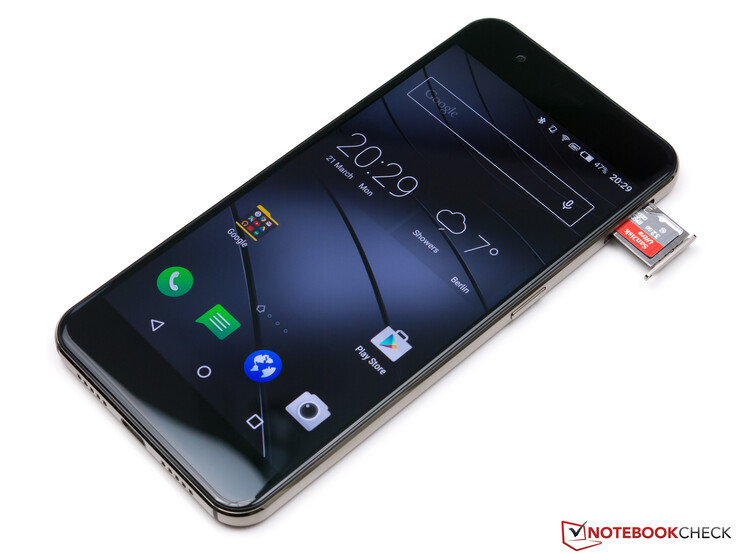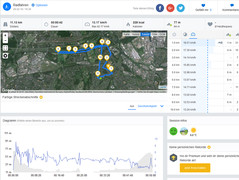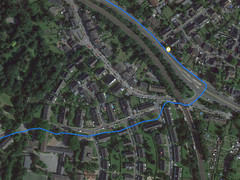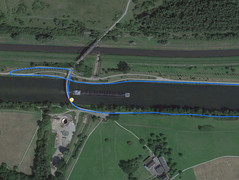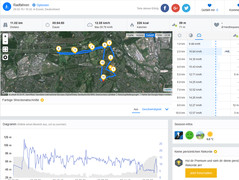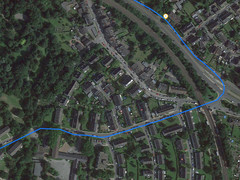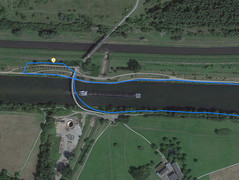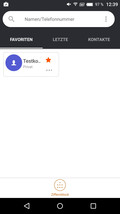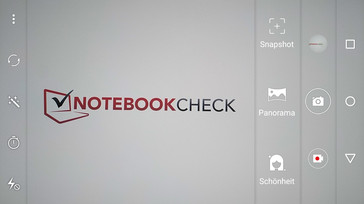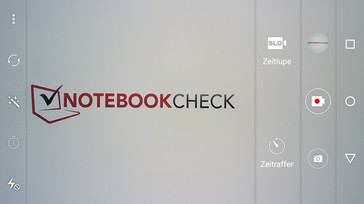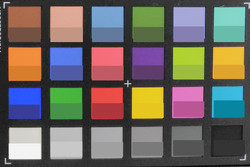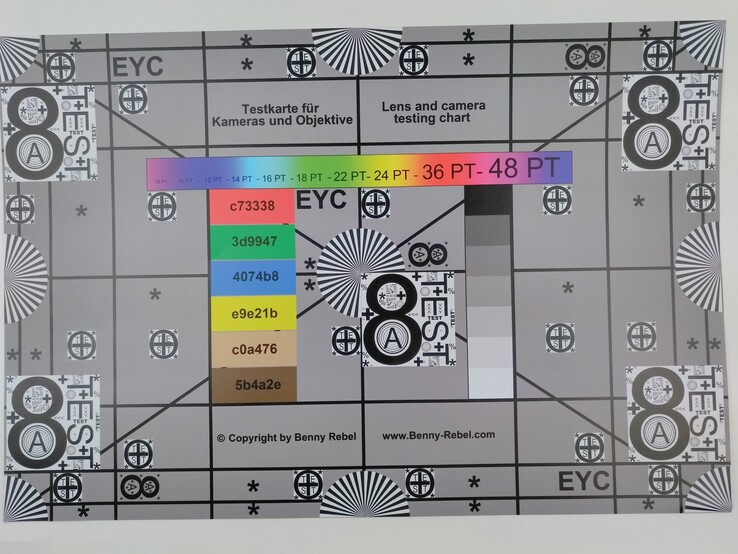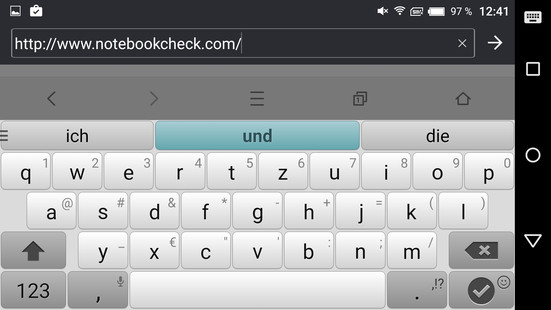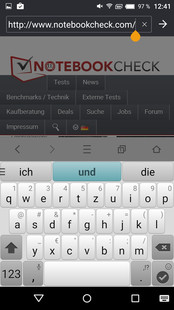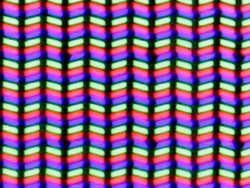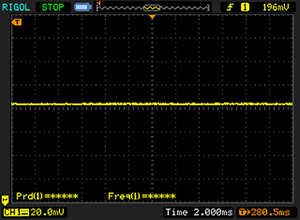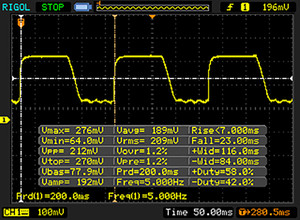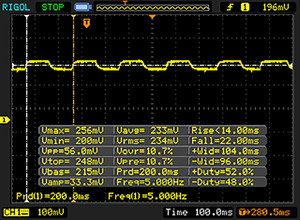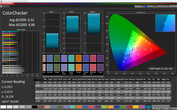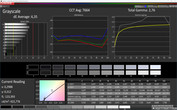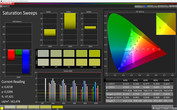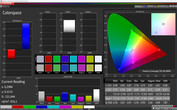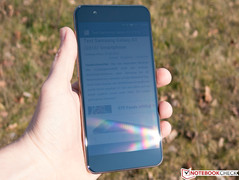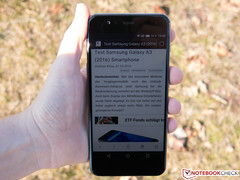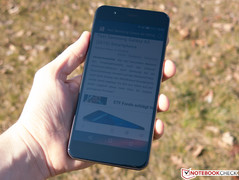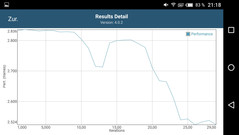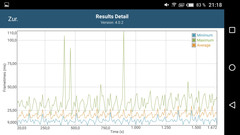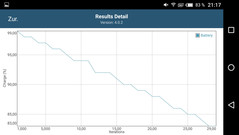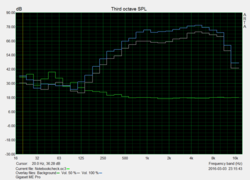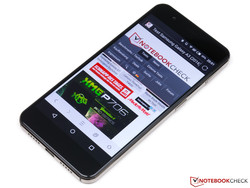Gigaset ME Pro Smartphone Review
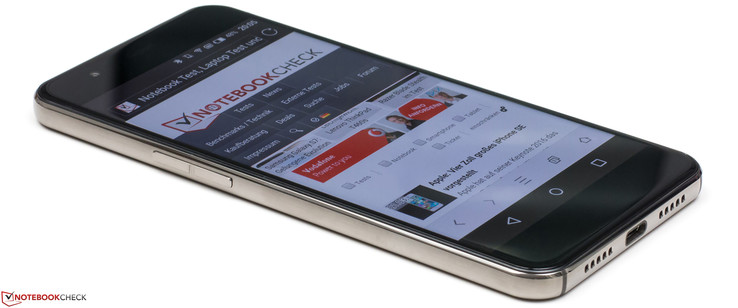
For the original German review, see here.
Many will still be familiar with the brand name Gigaset from DECT phones, but now there are also smartphones. Besides the 5-inch Gigaset ME Pure and ME (our review), there is also the 5.5-inch flagship called ME Pro in the still small lineup. It is only available in one configuration with 32 GB of internal storage, dual-SIM functionality as well as a black case for 549 Euros (~$623).
Rivals for the smartphone are therefore other Android based high-end devices like the more expensive Samsung Galaxy S7 Edge and Sony Xperia Z5 Premium, but also less expensive models like the OnePlus 2 or the LG G4, where the price has already dropped. Outside the Android universe are the iPhone 6S Plus as well as Microsoft's Lumia 950 XL that we use as comparison devices.
Case
Both sides of the Gigaset ME Pro are covered by Gorilla Glass, which has been slightly rounded towards the edges for a better feel in the hands. That you can still feel a slight transition between the front and the sides is a result of the thin display frame. Thanks to the materials used, the device leaves a very sophisticated impression, but can easily slip from angled surfaces due to the smooth back cover. The build quality of the card slot in particular is disappointing when you consider the otherwise flawless quality: The outer metal cover was very wobbly in our case, so usually it did not sit flush with the case and it often blocked when we inserted a card. Our review unit also shows small scratches on the glass back, even though we handled it very carefully.
We measured a thickness of 8.1 millimeters (~0.32 in; 7.7mm/.0.3 in according to the manufacturer), a height of 156 millimeters (~6.1 in) as well as a width of 76 millimeters (~0.3 in). These results are similar to the Sony Xperia Z5 Premium. An iPhone 6S Plus is even a few millimeters larger, but Samsung’s latest premium model Galaxy S7 Edge in particular shows that a 5.5-inch smartphone can be much more compact. We can also notice the good build quality as well as the large battery when we look at the weight: At 202 grams (~7 oz; 195 grams/6.8 oz according to the manufacturer) the review unit is the heaviest device within the comparison.
This construction has a positive effect on the stability. Neither concentrated pressure on the back nor twisting attempts are a problem, only unrealistically high amounts of pressure on the display itself will create small ripples on the screen – a good performance.
Connectivity
The memory equipment of the test model does not differ from its smaller sibling Gigaset ME: Besides 3 GB of RAM, the device has 32 GB of internal storage and you can use around 22 GB for your own files and apps. It is easy to expand the storage via microSD-card to a max. of 128 GB, but App2SD does not work. You also have to forgo a microSD when you use two SIM cards. One positive aspect is that both slots support LTE connections.
As well as the usual 3.5 mm headset port, you get a modern USB Type-C port. The connector is symmetric and can be attached both ways. According to the manufacturer, you get a USB 3.0 Type-C cable, but our review unit was shipped with only a USB 2.0 compatible USB Type-C to USB Type-A adapter. We tried a USB 3.0 cable and copied the test video Big Buck Bunny from a notebook with a USB 3.0 port and back to the notebook. The average transfer rate was just 24 MB/s, so it should be a USB 2.0 port at the smartphone. USB-OTG is not supported.
The Gigaset ME Pro supports Wi-Fi Direct as well as video output via Miracast, but not DLNS media streaming. An NFC module is not included.
According to the manufacturer the integrated notification LED can display only two colors (red and green) and other colors were not possible even with additional apps. A positive aspect is the extensive number of sensors: As well as the fingerprint scanner at the back, you get a heart rate monitor (to the left of the main camera), a UV sensor as well as an Infrared sensor and transmitter that can be used to control devices such as TVs, Blu-ray players as well as Hi-Fi systems with the corresponding app.
Software
The operating system of the review unit is Android 5.1.1 with the user interface Gigaset UI. There are some modifications, such as the absence of an app drawer similar to Huawei smartphones: Installed applications are displayed on the home screen and can be arranged in folders. The manufacturer has also installed a Power Saver and a Security app. The former can be used to activate several power saving features such as the automatic termination of background processes, while the latter includes, for example, a virus scanner and a rights manager for apps.
The UI is pretty convenient from a visual standpoint, but there are a few areas that still need some fine tuning: The column headers in the rights manager are tricky to read since they are never fully visible due to the narrow column design. It was also not possible to deactivate the sound when you take screenshots or the jingle when you turn the smartphone on.
We liked the small number of preloaded third-party apps ex-works: You only get Amazon’s Kindle app, Evernote as well as Gigaset’s Elements app to control smart home products. All three can be removed if necessary.
Communication & GPS
The Gigaset ME Pro supports Wi-Fi connections in both 2.4 as well as 5 GHz networks. Thanks to the modern AC standard and MiMo technology, the maximum transfer rate (gross) is 866 Mbps. We managed to reach this value in close proximity to an Asus RT-AC56U, but we noticed that it dropped the connection much earlier compared to other rivals when we increased the distance. We had already noticed a similar behavior in the smaller sibling Gigaset ME. Wireless connections with other devices can also be established via Bluetooth 4.1, but NFC is not available. The smartphone supports many frequencies and we did not notice any signal issues in the metropolitan area. Maximum LTE speeds are up to 300 Mbps for downstream and 50 Mbps for upstream (LTE Cat. 6).
The integrated GPS module, which also supports the satellite networks GLONASS and BeiDou, can find the position very quickly outdoors. The performance was not much worse indoors – such as in a one-storey supermarket. The location did not work on the third floor of a four-storey apartment building, even though the smartphone found some satellites. A comparison between the review unit and the bicycle navigation device Garmin Edge 500 is supposed to show if the results are also good in practice. Here we can see that the smartphone does not locate the position as often and there can be shortcuts, as in the two pictures with the bridge crossing and the turning point. However, the overall track length between the two devices differs by less than 1% and there are no huge outliers for the smartphone, so you can easily use it for navigation purposes.
Telephone & Voice Quality
The phone app of the Gigaset ME Pro is only slightly different from the normal Android counterpart in terms of functionality, but the design was adjusted to the user interface. The app supports features such as favorites, call histories, direct access to the contacts as well as a number pad. It is also possible to search by name or number.
As with the smaller sibling Gigaset ME, we are unfortunately not impressed by the voice quality when we use the earpiece for calls. The smartphone does not offer a normal, open speaker, but instead tones are transferred via "Surface Conduction" directly to the ear via vibrating glass surface. This means that both the volume as well as the sound can vary quite significantly depending on the position of the ear piece. The voice of our call partner also appears pretty unnatural and chopped. That the two microphones are not the best of their kind is confirmed by the tinny sound of the Gigaset user on the other side of the call.
Your call partner will sound much better when you use the hands-free feature, but we got complaints about a muffled sound from the other side of the call. There were also annoying noises such as echoes when both parties would talk simultaneously.
The best solution is to make calls with the supplied headset, which provided the most natural sound. The microphone on the other hand was not impressive.
Cameras & Multimedia
According to the manufacturer, the main camera of the Gigaset ME Pro takes pictures with a resolution of 20 MP as well as an aperture of f/2.2. However, the resolution is 5344x4008 pixels and the specification sheet shows a Sony IMX 230 sensor with optical image stabilization, and there is even a 21 MP camera. A true-tone LED flash is supposed to brighten up dark environments. The high resolution ensures good pictures, especially in bright environments, which can subjectively score with natural colors and good sharpness – the performance of the Gigaset ME Pro is also good compared to the rivals. You could criticize slightly blurry details, but you will have to zoom in quite a lot to see this. The indoor performance is also decent and the picture noise will only become more visible in low-light conditions, even though the LED flash can often help in these situations.
The webcam on the front uses an 8 MP sensor with an aperture of f/2.0. The picture quality is very good for a front camera. It takes sharp and detailed pictures in daylight and the quality is still decent in darker rooms, even though some pictures were rather blurry. You should, however, be careful when you also want to see the background on selfies, because objects at a distance of more than 1 meter (~3 ft) will be increasingly blurry. This will create a certain separation between the foreground and background.
The main camera can record videos in the rather exotic 2K resolution (2048x1080 pixels) at 30 frames per second, but you can also switch to the popular Full HD resolution (1920x1080 pixels). Unlike the pictures, the videos can hardly impress us: Despite the nominal high resolution, the results lack details and the autofocus tends to create pumping effects when we move the camera, which will also affect the picture quality. Only the pretty smooth playback is good. The rather bad sound quality matches the mediocre impression: Wind noises sound as if you are diving in a swimming pool, and voices are unnaturally distorted.
The Full HD videos of the webcam are slightly better in terms of picture quality, even though the focus range is – as with the pictures – limited to the immediate surroundings of the smartphone. The voice recordings stay artificial and distorted.
The camera app offers modes for time-lapse as well as slow-motions, and the picture mode also includes a panorama feature. However, the handling of the app is not always easy: The trigger is quite small and very close to the home button, so you can easily hit the wrong one. It is also unfortunate that you cannot start to record a video from within the picture mode – the displayed video button does not start the recording, but will only switch to the video mode. We did not like that – except for the silent mode – we could hear the confirmation sound when we started the video within the video itself. The current volume setting is completely ignored when you take a panorama, which can result in unwanted surprises when you take pictures in quiet environments.
Color Accuracy and Sharpness
We compare a picture of the X-Rite ColorChecker Passport under controlled lighting conditions with the actual reference colors to evaluate the color accuracy of the Gigaset's ME Pro main camera. The result is not edited afterwards and there is no manual white balance.
The Gigaset ME Pro shows a clear tendency to brighten and oversaturate the colors, but the differences will become blurred when we look at the grayscale: Bright test surfaces are too dark and dark surfaces too bright.
We take a picture of our test chart under controlled artificial light to evaluate the sharpness. Once again, we can see that darker areas are brightened up, which causes artifacts and inconsistency in colored areas. On the other hand, the camera resolution is quite high, even though Sony's Xperia Z5 Premium still has a visible advantage in this respect.
Accessories
Gigaset ships its premium smartphone in a nicely designed plastic box with a magnetic lock, so the first impression is already positive. As well as the usual brochures (quick-start guide, warranty and security information), the scope of delivery also includes an in-ear headset with metal elements and different ear pads, a quick charger with a flat cable as well as a slot tool with a rubberized frame.
Gigaset also offers an optional polycarbonate cover specifically designed for the ME Pro (11.99 Euros/~$14) and a leather cover for 29.99 Euros (~$34).
Warranty
Gigaset offers a 24-month warranty for the smartphone, but the battery and the PSU are only covered for six months, and the headset only for three months.
Input Devices & Handling
The physical buttons of the Gigaset ME Pro are made of metal and provide a pressure point, which is not too firm and easy to feel. The power button is rather wobbly, so it tends to clatter slightly when you press it.
The default keyboard of the Gigaset ME Pro, Swift Key, is integrated into the system, but you can also use Google's default input keyboard. The preloaded version is impressive with numerous settings as well as visual adaptability by themes.
The touchscreen, which is protected by Gorilla Glass, usually works well, but we noticed problems with our review unit when the power adapter was attached. Reliable inputs were only possible in this case if we also touched the metal frame at the same time – otherwise, the inputs were incorrect or not registered at all. We felt a slight tingling at the touch points of the hand and the metal frame during charging, which suggests that this phenomenon could be caused by an electrical interference. According to Gigaset this is an isolated issue, and the problem will be investigated after the review.
The integrated fingerprint scanner is a reliable method to unlock the smartphone, even though some rivals are subjectively quicker. It would have also been better for the handling if the sensor was easier to find with the fingers.
Considering the hardware of the premium smartphone, we were sometimes also disappointed by the subjective performance impression: There were some noticeable delays with background tasks such as app updates, as well as occasional delays when we closed apps.
Display
The Gigaset ME Pro has a 5.5-inch IPS display with 1920x1080 pixels. The resulting pixel density of 401 PPI is at the lower end within this comparison group – for example, the Sony Xperia Z5 Premium manages twice as much– but we can still not see individual pixels with the naked eye.
We can measure a center brightness of 424 cd/m² for the review unit on a completely white picture, which is lower compared to most comparison devices. We also check the brightness with an even distribution of dark and bright contents (average picture level/APL 50), but the results hardly change. The maximum luminance does drop to 407 cd/m² with the activated light sensor though, and is therefore slightly lower compared to the manual adjustment. Thanks to the low black value of just 0.21 cd/m², the Gigaset ME Pro manages an excellent contrast ratio of 2019:1 – one of the best results besides the rivals with AMOLED panels. Another positive aspect is that the smartphone does not use PWM to control the display brightness.
| |||||||||||||||||||||||||
Brightness Distribution: 91 %
Center on Battery: 424 cd/m²
Contrast: 2019:1 (Black: 0.21 cd/m²)
ΔE ColorChecker Calman: 6.32 | ∀{0.5-29.43 Ø4.79}
ΔE Greyscale Calman: 6.35 | ∀{0.09-98 Ø5}
Gamma: 2.76
CCT: 7664 K
| Gigaset ME Pro 1920x1080 px 5.5'' (IPS) | OnePlus 2 1920x1080 px 5.5'' (IPS) | Sony Xperia Z5 Premium 3840x2160 px 5.5'' (IPS) | LG G4 2560x1440 px 5.5'' (IPS) | Samsung Galaxy S7 Edge 2560x1440 px 5.5'' (AMOLED) | Microsoft Lumia 950 XL 2560x1440 px 5.7'' (AMOLED) | Apple iPhone 6S Plus 1920x1080 px 5.5'' (IPS) | |
|---|---|---|---|---|---|---|---|
| Screen | 3% | -34% | -14% | 48% | 19% | 0% | |
| Brightness middle (cd/m²) | 424 | 451 6% | 560 32% | 566 33% | 554 31% | 297 -30% | 583 38% |
| Brightness (cd/m²) | 409 | 446 9% | 541 32% | 536 31% | 552 35% | 297 -27% | 560 37% |
| Brightness Distribution (%) | 91 | 90 -1% | 85 -7% | 90 -1% | 96 5% | 93 2% | 91 0% |
| Black Level * (cd/m²) | 0.21 | 0.3 -43% | 0.45 -114% | 0.47 -124% | 0.46 -119% | ||
| Contrast (:1) | 2019 | 1503 -26% | 1244 -38% | 1204 -40% | 1267 -37% | ||
| Colorchecker dE 2000 * | 6.32 | 3.84 39% | 9.19 -45% | 6.17 2% | 1.59 75% | 2.67 58% | 3.55 44% |
| Colorchecker dE 2000 max. * | 8.98 | 15.01 -67% | 2.56 71% | 3.98 56% | |||
| Greyscale dE 2000 * | 6.35 | 3.97 37% | 10.58 -67% | 6.26 1% | 2.01 68% | 2.81 56% | 3.88 39% |
| Gamma | 2.76 80% | 2.46 89% | 2.7 81% | 2.48 89% | 2.01 109% | 2.08 106% | 2.2 100% |
| CCT | 7664 85% | 7283 89% | 9760 67% | 8171 80% | 6321 103% | 6379 102% | 7280 89% |
| Color Space (Percent of AdobeRGB 1998) (%) | 58.07 | 73.19 | 65.48 | 82.12 | 66.31 | 59.05 | |
| Color Space (Percent of sRGB) (%) | 90.14 | 98.63 | 99.98 | 99.79 | 92.8 |
* ... smaller is better
Screen Flickering / PWM (Pulse-Width Modulation)
| Screen flickering / PWM not detected | |||
In comparison: 53 % of all tested devices do not use PWM to dim the display. If PWM was detected, an average of 8152 (minimum: 5 - maximum: 343500) Hz was measured. | |||
Display Response Times
| ↔ Response Time Black to White | ||
|---|---|---|
| 30 ms ... rise ↗ and fall ↘ combined | ↗ 7 ms rise | |
| ↘ 23 ms fall | ||
| The screen shows slow response rates in our tests and will be unsatisfactory for gamers. In comparison, all tested devices range from 0.1 (minimum) to 240 (maximum) ms. » 79 % of all devices are better. This means that the measured response time is worse than the average of all tested devices (20.3 ms). | ||
| ↔ Response Time 50% Grey to 80% Grey | ||
| 36 ms ... rise ↗ and fall ↘ combined | ↗ 14 ms rise | |
| ↘ 22 ms fall | ||
| The screen shows slow response rates in our tests and will be unsatisfactory for gamers. In comparison, all tested devices range from 0.165 (minimum) to 636 (maximum) ms. » 49 % of all devices are better. This means that the measured response time is worse than the average of all tested devices (31.7 ms). | ||
We can measure an average DeltaE deviations of 6.32 (ColorChecker) and 6.35 (Grayscale) compared to the sRGB reference color space ex-works. These results are clearly above the ideal range (DeltaE < 3) and many of the other premium devices manage more accurate colors as well. However, the Sony Xperia Z5 Premium is even worse. The color temperature of the review unit is too cool at 7664 K (ideal: 6500 K) and the gamma value is also too high at 2.76 (ideal: 2.2).
The display brightness is sufficient when you want to read the display outdoors in the shade or on an overcast day. At least fonts are also visible under direct sunlight thanks to the high contrast ratio.
Performance
While there are already some devices with Qualcomm's new flagship SoC Snapdragon 820, the Gigaset ME Pro still uses its predecessor, Snapdragon 810, which can be found in many premium smartphones from 2015. The octa-core processor has four fast Cortex-A57 cores running at up to 1.8 GHz as well as four more fugal Cortex-A53 cores. You also get 3 GB of memory while the graphics are handled by the Adreno 430 GPU.
Our test model has to compete with the flagship devices from the other manufacturers, so it is usually in the lower part of the middle range in the graphics benchmarks. The situation is not better in PCMark or Basemark OS II, where the Gigaset ME Pro is always on one of the last places.
| PCMark for Android - Work performance score (sort by value) | |
| Gigaset ME Pro | |
| OnePlus 2 | |
| Sony Xperia Z5 Premium | |
| LG G4 | |
| Samsung Galaxy S7 Edge | |
| AnTuTu v6 - Total Score (sort by value) | |
| Gigaset ME Pro | |
| OnePlus 2 | |
| Sony Xperia Z5 Premium | |
| Samsung Galaxy S7 Edge | |
| Microsoft Lumia 950 XL | |
| Apple iPhone 6S Plus | |
| GFXBench (DX / GLBenchmark) 2.7 | |
| T-Rex Onscreen (sort by value) | |
| Gigaset ME Pro | |
| OnePlus 2 | |
| Sony Xperia Z5 Premium | |
| LG G4 | |
| Samsung Galaxy S7 Edge | |
| Microsoft Lumia 950 XL | |
| Apple iPhone 6S Plus | |
| 1920x1080 T-Rex Offscreen (sort by value) | |
| Gigaset ME Pro | |
| OnePlus 2 | |
| Sony Xperia Z5 Premium | |
| LG G4 | |
| Samsung Galaxy S7 Edge | |
| Microsoft Lumia 950 XL | |
| Apple iPhone 6S Plus | |
| GFXBench 3.0 | |
| 1920x1080 1080p Manhattan Offscreen (sort by value) | |
| Gigaset ME Pro | |
| OnePlus 2 | |
| Sony Xperia Z5 Premium | |
| LG G4 | |
| Samsung Galaxy S7 Edge | |
| Microsoft Lumia 950 XL | |
| Apple iPhone 6S Plus | |
| on screen Manhattan Onscreen OGL (sort by value) | |
| Gigaset ME Pro | |
| OnePlus 2 | |
| Sony Xperia Z5 Premium | |
| LG G4 | |
| Samsung Galaxy S7 Edge | |
| Microsoft Lumia 950 XL | |
| Apple iPhone 6S Plus | |
| GFXBench 3.1 | |
| 1920x1080 Manhattan ES 3.1 Offscreen (sort by value) | |
| Gigaset ME Pro | |
| OnePlus 2 | |
| Sony Xperia Z5 Premium | |
| LG G4 | |
| Samsung Galaxy S7 Edge | |
| Apple iPhone 6S Plus | |
| on screen Manhattan ES 3.1 Onscreen (sort by value) | |
| Gigaset ME Pro | |
| OnePlus 2 | |
| Sony Xperia Z5 Premium | |
| LG G4 | |
| Samsung Galaxy S7 Edge | |
| Apple iPhone 6S Plus | |
| GFXBench | |
| 1920x1080 Car Chase Offscreen (sort by value) | |
| Gigaset ME Pro | |
| OnePlus 2 | |
| Sony Xperia Z5 Premium | |
| Samsung Galaxy S7 Edge | |
| on screen Car Chase Onscreen (sort by value) | |
| Gigaset ME Pro | |
| OnePlus 2 | |
| Sony Xperia Z5 Premium | |
| Samsung Galaxy S7 Edge | |
| 3DMark | |
| 1280x720 offscreen Ice Storm Unlimited Score (sort by value) | |
| Gigaset ME Pro | |
| OnePlus 2 | |
| Sony Xperia Z5 Premium | |
| LG G4 | |
| Samsung Galaxy S7 Edge | |
| Apple iPhone 6S Plus | |
| 1280x720 offscreen Ice Storm Unlimited Graphics Score (sort by value) | |
| Gigaset ME Pro | |
| OnePlus 2 | |
| Sony Xperia Z5 Premium | |
| LG G4 | |
| Samsung Galaxy S7 Edge | |
| Apple iPhone 6S Plus | |
| 1280x720 offscreen Ice Storm Unlimited Physics (sort by value) | |
| Gigaset ME Pro | |
| OnePlus 2 | |
| Sony Xperia Z5 Premium | |
| LG G4 | |
| Samsung Galaxy S7 Edge | |
| Apple iPhone 6S Plus | |
| 2560x1440 Sling Shot Extreme (ES 3.1) Physics (sort by value) | |
| Gigaset ME Pro | |
| OnePlus 2 | |
| Sony Xperia Z5 Premium | |
| LG G4 | |
| Samsung Galaxy S7 Edge | |
| Apple iPhone 6S Plus | |
| 2560x1440 Sling Shot Extreme (ES 3.1) Graphics (sort by value) | |
| Gigaset ME Pro | |
| OnePlus 2 | |
| Sony Xperia Z5 Premium | |
| LG G4 | |
| Samsung Galaxy S7 Edge | |
| Apple iPhone 6S Plus | |
| 2560x1440 Sling Shot Extreme (ES 3.1) (sort by value) | |
| Gigaset ME Pro | |
| OnePlus 2 | |
| Sony Xperia Z5 Premium | |
| LG G4 | |
| Samsung Galaxy S7 Edge | |
| Apple iPhone 6S Plus | |
Once again, our review unit is rather average in the browser benchmarks Octane V2, Mozilla Kraken as well as WebXPRT 2015, while it is the slowest device in the JetStream benchmark. Other devices with the Snapdragon 810 SoC – such as the Sony Xperia Z5 Premium – are up to 30% faster in this case.
| Octane V2 - Total Score (sort by value) | |
| Gigaset ME Pro | |
| OnePlus 2 | |
| Sony Xperia Z5 Premium | |
| LG G4 | |
| Samsung Galaxy S7 Edge | |
| Microsoft Lumia 950 XL | |
| Apple iPhone 6S Plus | |
| Mozilla Kraken 1.1 - Total (sort by value) | |
| Gigaset ME Pro | |
| OnePlus 2 | |
| Sony Xperia Z5 Premium | |
| LG G4 | |
| Samsung Galaxy S7 Edge | |
| Microsoft Lumia 950 XL | |
| Apple iPhone 6S Plus | |
| WebXPRT 2015 - Overall (sort by value) | |
| Gigaset ME Pro | |
| OnePlus 2 | |
| Sony Xperia Z5 Premium | |
| LG G4 | |
| Samsung Galaxy S7 Edge | |
| Microsoft Lumia 950 XL | |
| Apple iPhone 6S Plus | |
| JetStream 1.1 - Total Score (sort by value) | |
| Gigaset ME Pro | |
| OnePlus 2 | |
| Sony Xperia Z5 Premium | |
| LG G4 | |
| Samsung Galaxy S7 Edge | |
| Microsoft Lumia 950 XL | |
| Apple iPhone 6S Plus | |
* ... smaller is better
The storage benchmarks might show a possible reason for the below-average performance in the previous tests: The transfer rates determined by AndroBench 3 are roughly on par with the OnePlus 2, but both the LG G4 as well as the brand-new Samsung Galaxy S7 Edge in particular, are significantly faster. BaseMark OS II even ranks our review unit in the last place within the comparison.
We checked the performance of the microSD slot with our reference card Toshiba Exceria Pro M401 (THN-M401S064E2, UHS-I Class 3, up to 95 MB/s read and 80 MB/s write). The results for sequential read and write operations are decent with 63 MB/s and 24.19 MB/s, respectively, but the write result in particular could be better.
| AndroBench 3-5 | |
| Random Write 4KB (sort by value) | |
| Gigaset ME Pro | |
| OnePlus 2 | |
| Sony Xperia Z5 Premium | |
| LG G4 | |
| Samsung Galaxy S7 Edge | |
| Random Read 4KB (sort by value) | |
| Gigaset ME Pro | |
| OnePlus 2 | |
| Sony Xperia Z5 Premium | |
| LG G4 | |
| Samsung Galaxy S7 Edge | |
| Sequential Write 256KB (sort by value) | |
| Gigaset ME Pro | |
| OnePlus 2 | |
| Sony Xperia Z5 Premium | |
| LG G4 | |
| Samsung Galaxy S7 Edge | |
| Sequential Read 256KB (sort by value) | |
| Gigaset ME Pro | |
| OnePlus 2 | |
| Sony Xperia Z5 Premium | |
| LG G4 | |
| Samsung Galaxy S7 Edge | |
| BaseMark OS II - Memory (sort by value) | |
| Gigaset ME Pro | |
| OnePlus 2 | |
| Sony Xperia Z5 Premium | |
| LG G4 | |
| Samsung Galaxy S7 Edge | |
| Microsoft Lumia 950 XL | |
| Apple iPhone 6S Plus | |
Games
Graphics are handled by the Adreno 430 GPU and it does not have any problems with the Full HD resolution of the Gigaset ME Pro. Even demanding games like “Asphalt 8” as well as “Dead Trigger 2” always run smoothly. We also liked the precision of the integrated position sensors during gaming, but it is not convenient since the speaker at the side is quickly covered by the hand when you play in landscape mode.
| Asphalt 8: Airborne | |||
| Settings | Value | ||
| high | 29 fps | ||
| very low | 25 fps | ||
| Dead Trigger 2 | |||
| Settings | Value | ||
| high | 30 fps | ||
Emissions
Temperature
There are no surprises in terms of temperature development: Both the idle and the load results of the Gigaset ME Pro are comparable to many other competitors. We can measure a maximum surface temperature of 43.3 °C (~110 °F). Only Samsung's new Galaxy S7 Edge is much cooler, while the Microsoft Lumia 950 XL is much warmer at up to 48.3 °C (~119 °F).
When we ran the battery test of GFX Bench, which repeats the T-Rex test thirty times in a row, we were under the impression that the metal frame in particular would get inconveniently hot. While the OnePlus 2 and the Sony Xperia Z5 Premium – both use the Snapdragon 810 SoC as well – already start to throttle in the fourth run, the review unit can maintain the maximum performance for nine runs. The maximum performance of the review unit is right between the other two comparison devices, and it drops by up to 11% over the course of the test. The throttling is therefore very moderate compared to the rivals (Sony Xperia Z5 Premium: -25%; OnePlus 2: -33%).The Microsoft Lumia 950 XL (-14.5%) with the same SoC is on a similarly good level.
(±) The maximum temperature on the upper side is 43.3 °C / 110 F, compared to the average of 35.2 °C / 95 F, ranging from 21.9 to 247 °C for the class Smartphone.
(±) The bottom heats up to a maximum of 42.7 °C / 109 F, compared to the average of 34 °C / 93 F
(+) In idle usage, the average temperature for the upper side is 30.6 °C / 87 F, compared to the device average of 32.9 °C / 91 F.
Speakers
The speaker of the Gigaset ME Pro is situated on the left, next to the USB Type-C port and reaches up to 87.54 dB(A), which is sufficient for medium-sized rooms. Our measurements also show that – like most smartphones – there are drawbacks in terms of super high tones and bass. However, considering the small size of the smartphone speaker the result is quite decent: Voices and music sound – except for the mentioned deficits – quite balanced. There will only be audible distortions at higher volumes or when you listen to very bass-heavy titles.
The provided in-ear headset leaves a good impression both in terms of the quality as well as the sound.
Energy Management
Power Consumption
For the past few months we have been using a new measurement device, which is much more accurate than before and therefore the results in the following table cannot be compared directly with each other. You can, however, see that the review unit is – except for the extreme values – more frugal than the Sony Xperia Z5 Premium with a UHD screen and the same SoC. Microsoft's Lumia 950 XL with another OS also consumes more energy and only has an advantage under load. That premium devices can also be frugal is shown by the new Samsung Galaxy S7 Edge. A small problem is the rather high consumption of the review unit when it is turned off as well as in standby, which was already the case for the smaller sibling Gigaset ME.
The supplied quick-charger provides up to 2 A with 5 V or 9 V, and still 1.5 A at 12 V. The large 4000 mAh battery of the Gigaset ME Pro takes about 2.5 hours for a full charge. It is integrated and can therefore not be replaced by the user.
| Off / Standby | |
| Idle | |
| Load |
|
Key:
min: | |
| Gigaset ME Pro Adreno 430, 810 MSM8994, 32 GB eMMC Flash | OnePlus 2 Adreno 430, 810 MSM8994, 64 GB eMMC Flash | Sony Xperia Z5 Premium Adreno 430, 810 MSM8994, 32 GB eMMC Flash | LG G4 Adreno 418, 808 MSM8992, 32 GB eMMC Flash | Samsung Galaxy S7 Edge Mali-T880 MP12, Exynos 8890, 32 GB UFS 2.0 Flash | Microsoft Lumia 950 XL Adreno 430, 810 MSM8994, 32 GB eMMC Flash | Apple iPhone 6S Plus A9 / PowerVR GT7600, A9, Apple AP0064K (iPhone NVMe) | |
|---|---|---|---|---|---|---|---|
| Power Consumption | 18% | -12% | 1% | 26% | -78% | 20% | |
| Idle Minimum * (Watt) | 0.94 | 0.6 36% | 0.83 12% | 1.1 -17% | 0.63 33% | 2.85 -203% | 0.5 47% |
| Idle Average * (Watt) | 1.61 | 1.7 -6% | 2.36 -47% | 1.5 7% | 1.1 32% | 2.95 -83% | 1.9 -18% |
| Idle Maximum * (Watt) | 1.75 | 1.8 -3% | 2.42 -38% | 1.9 -9% | 1.56 11% | 3.26 -86% | 2.2 -26% |
| Load Average * (Watt) | 6.45 | 5.7 12% | 7.27 -13% | 6.6 -2% | 5.95 8% | 8.92 -38% | 3.2 50% |
| Load Maximum * (Watt) | 12.05 | 6 50% | 9.18 24% | 8.8 27% | 6.7 44% | 9.39 22% | 6.4 47% |
* ... smaller is better
Battery Runtime
Thanks to the large battery, the review unit manages good scores in this section. Runtimes of more than 7 hours in the Wi-Fi test and more than 11 hours in the video test beat many rivals. Only the Samsung Galaxy S7 Edge and the iPhone 6S Plus have even more stamina.
To improve the battery runtimes without recharging, Gigaset has implemented an ultra-power saver mode, but it will limit the functionality of the smartphone to calls, messages, contacts and alarms.
| Gigaset ME Pro Adreno 430, 810 MSM8994, 32 GB eMMC Flash | OnePlus 2 Adreno 430, 810 MSM8994, 64 GB eMMC Flash | Sony Xperia Z5 Premium Adreno 430, 810 MSM8994, 32 GB eMMC Flash | LG G4 Adreno 418, 808 MSM8992, 32 GB eMMC Flash | Samsung Galaxy S7 Edge Mali-T880 MP12, Exynos 8890, 32 GB UFS 2.0 Flash | Microsoft Lumia 950 XL Adreno 430, 810 MSM8994, 32 GB eMMC Flash | Apple iPhone 6S Plus A9 / PowerVR GT7600, A9, Apple AP0064K (iPhone NVMe) | |
|---|---|---|---|---|---|---|---|
| Battery runtime | -13% | -22% | -24% | 41% | -21% | 3% | |
| Reader / Idle (h) | 24.8 | 23.2 -6% | 21.3 -14% | 27.6 11% | 27.7 12% | 18 -27% | 27.6 11% |
| H.264 (h) | 11.2 | 9.7 -13% | 6.9 -38% | 8.4 -25% | 15.2 36% | 10.2 -9% | 11.9 6% |
| WiFi v1.3 (h) | 7.2 | 5.9 -18% | 6.2 -14% | 5.4 -25% | 12.2 69% | 6.2 -14% | 8.6 19% |
| Load (h) | 4.4 | 3.8 -14% | 3.5 -20% | 1.9 -57% | 6.5 48% | 3 -32% | 3.3 -25% |
Pros
Cons
Verdict
You can immediately see that the Gigaset ME Pro was designed as a sophisticated alternative for the established rivals: Glass and metal result in a solid and – except for the slot cover – very well-built product. The heart of the smartphone is the hot-headed Snapdragon 810 SoC, but Gigaset keeps it well under control. The sensor equipment in particular is very comprehensive and also includes a UV sensor, a heart rate monitor and the almost mandatory fingerprint scanner. You also get an IR transmitter to control your home theater. It is unfortunate that the modern USB Type-C port does not support USB-OTG and that the manufacturer does not implement an NFC module. If you need more than 32 GB of storage, you can use a MicroSD-card, but you will have to forego the dual-SIM feature in this case.
Gigaset's user interface is appealing with its unified design as well as the integrated rights manager for apps, but there are still some minor bugs. There can also be short stutters or delays despite the powerful SoC – a software update might be able to improve the situation. The touchscreen issue during the charging on the other hand should be pretty hard to fix. According to the manufacturer, this unusual behavior was limited to our review unit so far, so you should not be too worried.
While the two cameras take decent pictures, the video quality is just mediocre and the recorded sound in particular cannot impress us. The manufacturer should also improve the call quality: The unconventionally designed earpiece cannot impress with its sound and the voice of the Gigaset user is not transferred in the best quality, either. A better fit for a flagship smartphone is the IPS display with wide viewing angles, which manages very high contrast ratios thanks to the rich black value. The package is rounded off by very long battery runtimes.
Gigaset's premium smartphone ME Pro can particularly impress with a good display, long battery runtimes and an elegant design. Potential buyers will, however, have to live with minor drawbacks like the missing NFC support or the mediocre voice quality during calls.
Priced at around 550 Euros (~$625), the Gigaset ME Pro is rather more affordable than many established competitors at their launch. If you can forgo the microSD slot, the Infrared transmitter as well as the rear cover made of glass, you will get the OnePlus 2, which is very similar from a technological point of view – for 200 Euros (~$227) less.
Gigaset ME Pro
- 04/18/2016 v5.1 (old)
Andreas Kilian




